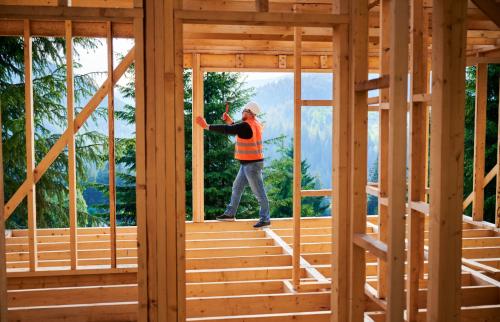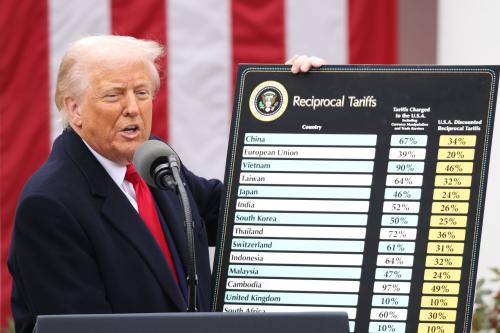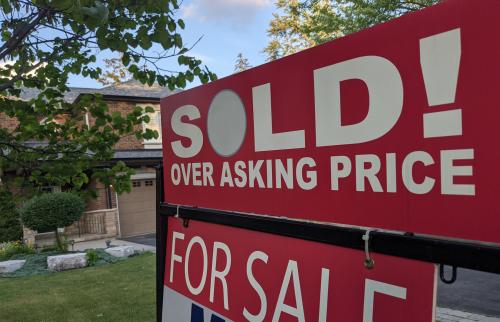The U.S. faces a housing shortage measured in the millions of units, and families are struggling with historically high rents and home prices. The Trump administration has expressed a goal to reduce the cost of living and make housing more affordable, and may declare a national housing emergency. But it is also imposing new or elevated tariffs on lumber, gypsum, steel, and now, kitchen cabinets, bathroom vanities, and other related products, the very materials that builders need to construct new homes.
These taxes raise costs across the board—whether for new construction, renovations, or affordable housing development. Using TPC’s tariff model, we calculated that current tariffs, including those just announced, will add roughly $30 billion to the costs of investment in residential structures. Our calculations show that about 90% of the costs to residential investment will fall on construction of new homes, including apartments.
They will also affect homeowners renovating their homes or doing normal maintenance. Likewise, buying appliances and furniture will become more expensive. Already for 2025, we calculate the prices of major appliances have gone up more than twice as fast as overall inflation, and living room, kitchen, and dining room furniture have gone up more than 75% faster.
Such costly tariff policies risk deepening the housing crisis.
Why have new and higher tariffs been imposed?
Temporary or targeted tariffs can safeguard a critical industry or respond to unfair trade practices. U.S. trade law provides two main paths for doing so. The first is Section 232 of the Trade Expansion Act of 1962, which allows the executive branch to impose tariffs when imports are claimed to threaten national security. The second is designed to counter unfairly priced or subsidized imports, through the countervailing and anti-dumping provisions of the Tariff Act of 1930.
Tariffs on steel and aluminum follow the first path: In 2018, the Trump administration imposed Section 232 tariffs of 25%, citing national security concerns about the need to maintain domestic capacity. The Biden administration largely kept those tariffs in place, albeit with negotiated adjustments for some trading partners, and the second Trump administration doubled down. The national security rationale has been controversial: Some have raised questions about whether the risks these tariffs were meant to address were well-founded.
Tariffs on lumber have historically followed the second track. For decades, U.S. officials have imposed anti-dumping and countervailing duties on Canadian softwood lumber, arguing that subsidized access to timber allowed Canadian producers to undercut U.S. mills.
A new approach, and a third track, with costly consequences
The Trump administration is taking a new approach in 2025 by taking lumber and its “derivative products” down the national security track. That order imposes a 10% tariff on softwood timber and lumber, 25% on upholstered wooden products, and 25% on kitchen cabinets and vanities, effective October 14.
Furthermore, the tariffs on upholstered products, kitchen cabinets, and vanities—staples of residential construction versus defense production—are scheduled to rise again to 30% and 50% on January 1, 2026.
On top of these measures, the Trump administration has also used the International Emergency Economic Powers Act (IEEPA), which grants the executive branch power to regulate certain economic activity during a national emergency, to levy broad duties on imports from Mexico, Canada, and China. Announced in early 2025, these tariffs apply to a wide range of products, effectively adding another surcharge to many building materials that the U.S. imports in large quantities.
Gypsum—a mineral used in drywall—illustrates the risk to residential construction from IEEPA tariffs: More than half of U.S. gypsum imports come from Canada and Mexico. Doors, windows, and frames face similar IEEPA tariff pressures: A significant share of U.S. supply comes from Canada and China. Adding to builders’ and suppliers’ uncertainty: These tariffs remain on unsettled legal footing, since the constitutionality of this application of the IEEPA is now pending before the Supreme Court.
Taken together, these layered tariffs add significant costs to housing construction.
New and higher tariffs will exacerbate the residential housing crisis
The U.S. is short millions of homes, and the shortage affects every corner of the market. Analysis routinely finds that the U.S. is underbuilt by 3 to 5 million housing units relative to long-run demand. For example, Freddie Mac’s latest analysis puts the deficit at about 3.7 million units, while Brookings research estimates the gap to be 4.9 million. The Harvard Joint Center for Housing Studies, in its 2025 State of the Nation’s Housing report, highlights that new multifamily development is slowing despite record rents due to higher costs and that nearly half of renters are cost-burdened—spending over 30% of their income on housing.
The problem is even more acute at the bottom of the market: The National Low Income Housing Coalition estimates a shortage of more than 7 million affordable rental homes for extremely low-income households.
While methodologies differ, the broader research consensus is clear: The shortage is real, severe, and a central driver of today’s affordability crisis.
The Trump administration’s recent tariff actions expose a growing contradiction. Federal and state programs work to relieve the housing shortage. At every level of government, there are efforts underway to lower the cost of housing and expand supply, from the recent expansion of the Low-Income Housing Tax Credit in the tax bill passed this summer, to block grants that support housing and zoning reforms, and infrastructure investments designed to encourage new construction.
Tariffs on the very materials required to build new homes cut against efforts to build supply, add costs, and slow production. If the Trump administration aims to make housing more affordable, trade policy that seeks to protect the U.S. should support U.S. housing policy, not work against it.
The Brookings Institution is committed to quality, independence, and impact.
We are supported by a diverse array of funders. In line with our values and policies, each Brookings publication represents the sole views of its author(s).







Commentary
Recent tariffs threaten residential construction
October 3, 2025